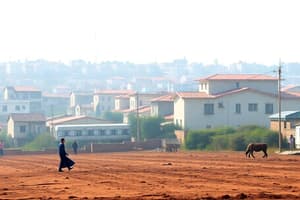Podcast
Questions and Answers
What is the primary factor that affects population growth rate?
What is the primary factor that affects population growth rate?
- Migration
- Mortality rate
- Urbanization rate
- Fertility rate (correct)
In which stage of the Demographic Transition do improvements in healthcare lead to decreased mortality rates?
In which stage of the Demographic Transition do improvements in healthcare lead to decreased mortality rates?
- Stage 1
- Stage 3
- Stage 4
- Stage 2 (correct)
What is the most commonly used population projection?
What is the most commonly used population projection?
- Medium-variant projection (correct)
- Low-variant projection
- High-variant projection
- Constant fertility projection
What is the primary driver of urban population growth?
What is the primary driver of urban population growth?
What is a consequence of rapid urbanization?
What is a consequence of rapid urbanization?
Which of the following is a characteristic of Stage 4 of the Demographic Transition?
Which of the following is a characteristic of Stage 4 of the Demographic Transition?
What is a factor that contributes to projection uncertainty in population projections?
What is a factor that contributes to projection uncertainty in population projections?
What is the term for the movement of people from one place to another, affecting population growth?
What is the term for the movement of people from one place to another, affecting population growth?
Flashcards are hidden until you start studying
Study Notes
Population Dynamics
- Population growth rate: The rate at which a population increases or decreases in size over time.
- Fertility rate: The average number of children a woman would have in her lifetime, calculated by the total fertility rate (TFR).
- Mortality rate: The number of deaths per 1,000 individuals in a population.
- Migration: The movement of people from one place to another, affecting population growth.
Demographic Transition
- Stage 1: High birth and death rates: Characterized by high population growth rates, typically seen in developing countries.
- Stage 2: Decreasing death rates: Improvements in healthcare lead to decreased mortality rates, causing population growth to accelerate.
- Stage 3: Decreasing birth rates: As economies develop, birth rates decrease, leading to slower population growth.
- Stage 4: Low birth and death rates: Characterized by low population growth rates, typically seen in developed countries.
Population Projections
- Medium-variant projection: The most commonly used projection, assuming a decline in fertility rates and an increase in life expectancy.
- High-variant projection: Assumes higher fertility rates and lower life expectancy, resulting in a larger population.
- Low-variant projection: Assumes lower fertility rates and higher life expectancy, resulting in a smaller population.
- Projection uncertainty: Projections are subject to uncertainty due to factors such as changes in fertility rates, mortality rates, and migration.
Urbanization
- Urbanization rate: The rate at which people move from rural to urban areas.
- Urban population growth: The growth of urban populations, driven by migration and natural increase.
- Urbanization challenges: Increased pressure on urban infrastructure, services, and resources, leading to issues such as housing, transportation, and sanitation.
Impact on Resources
- Food security: Population growth puts pressure on global food supplies, leading to concerns about food security and sustainability.
- Water scarcity: Increasing demand for water due to population growth, leading to water scarcity and competition for this limited resource.
- Energy consumption: Growing population leads to increased energy demand, contributing to greenhouse gas emissions and climate change.
- Resource depletion: Population growth contributes to the depletion of natural resources, such as forests, fisheries, and minerals.
Population Dynamics
- Population growth rate measures the change in population size over time.
- Fertility rate is the average number of children a woman would have in her lifetime, with a total fertility rate (TFR) of 2.1 being replacement rate.
- Mortality rate is the number of deaths per 1,000 individuals in a population.
Demographic Transition
- Stage 1: High birth and death rates cause high population growth rates, typical in developing countries.
- Stage 2: Decreasing death rates due to improved healthcare accelerate population growth.
- Stage 3: Decreasing birth rates due to economic development lead to slower population growth.
- Stage 4: Low birth and death rates result in low population growth rates, typical in developed countries.
Population Projections
- Medium-variant projection assumes declining fertility rates and increasing life expectancy, resulting in moderate population growth.
- High-variant projection assumes higher fertility rates and lower life expectancy, resulting in larger population growth.
- Low-variant projection assumes lower fertility rates and higher life expectancy, resulting in smaller population growth.
- Projections are subject to uncertainty due to factors such as changing fertility rates, mortality rates, and migration.
Urbanization
- Urbanization rate measures the movement of people from rural to urban areas.
- Urban population growth is driven by migration and natural increase.
- Urbanization challenges include pressure on infrastructure, services, and resources, leading to issues like housing, transportation, and sanitation.
Impact on Resources
- Population growth puts pressure on global food supplies, threatening food security and sustainability.
- Increasing demand for water due to population growth leads to water scarcity and competition for this limited resource.
- Growing population leads to increased energy demand, contributing to greenhouse gas emissions and climate change.
- Population growth contributes to the depletion of natural resources, such as forests, fisheries, and minerals.
Studying That Suits You
Use AI to generate personalized quizzes and flashcards to suit your learning preferences.



